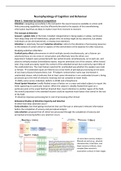Summary
Summary Neurophysiology of Cognition and Behavior - Radboud University
- Course
- Institution
In this document is all information needed for the exam. I studied the content of just this summary and passed with a 9. the summary is structured according to the lectures of each week's topic.
[Show more]



